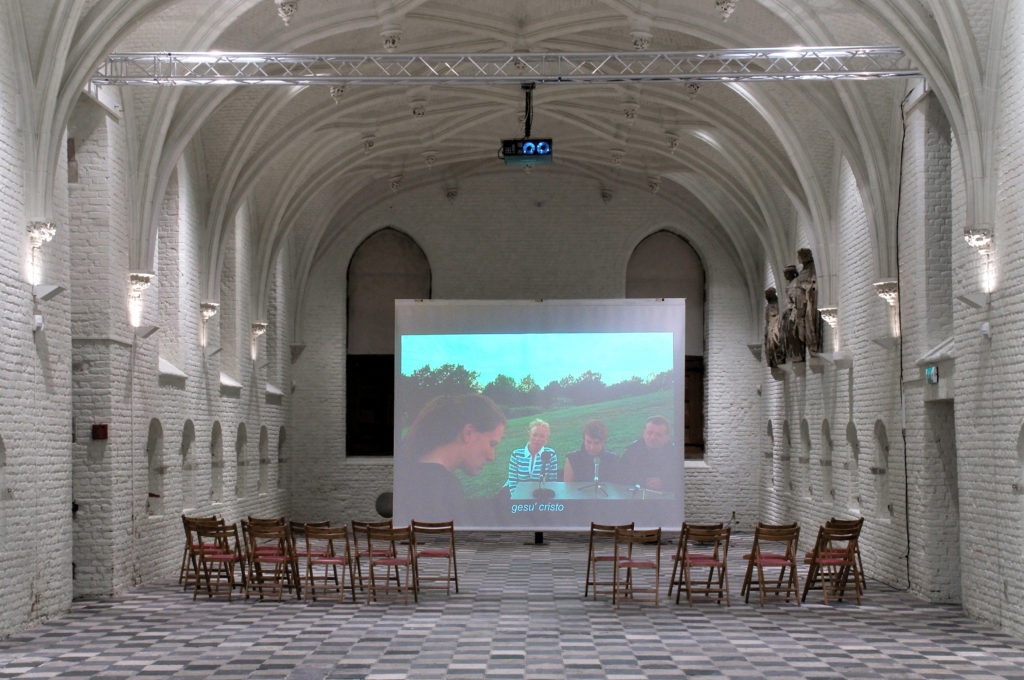Screensaver – Open Video Projects
Elisabetta Benassi, Johanna Billing, Keren Cytter, goldiechiari, Jesper Just, Rä Di Martino, Ursula Mayer, Olaf Nicolai, Mathew Sawyer, Manuel Saiz, Patrick Ward, Clemens von Wedemeyer, Guido van der Werve
Group exhibition
30 October – 7 November 2010
Vleeshal (Map)
Curators: Sarra Brill, Giovanna Felluga, Lorenzo Benedetti

The element of reflexivity is the connective fabric in this selection of artists’ film and video: reflexivity used as a creative tool, as a protagonist element in video and point of departure for the analysis of artistic and cinematographic language. From the darkened theater of the film festival to an institution dedicated to art, ScreenSaver becomes itself a mode of reflexivity, shifting the viewer into a space where cinema becomes an object of art.
The first part of the programme that Open Video Projects presents at De Vleeshal is called 'Behind the curtains and back again'. This series spotlights the border between the illusion created by cinema and the “reality” of the behind the scenes.
The works have in common their use of reflexivity as a device to complicate narrative structure. Consequently, the narrative of each work is effected through a reconstruction of a film world, which is deconstructing before our eyes. Reflexivity comes in the form of recognizable references to another filmic styles, which break our reverie from the current film-text and allows us to contemplate the larger context of cinema. Keren Cytter’s 'Untitled' (2009) takes inspiration from John Cassavetes’ 'Opening Night' (1977), and Elisabetta Benassi’s 'Time Code' (2002) breathes life back into Pier Paolo Pasolini using the soundtrack of the director’s 'The Hawks and the Sparrows' (1966). The mechanism of reflexivity is also achieved by way of a privileged gaze that removes us from the story world, leading us behind the scenes. A seemingly impromptu discussion between two actors in Manuel Saiz’s 'The Two Teams Team' (2008) reveals that the essential dialogue is really spoken between takes, while Clemens von Wedemeyer’s 'Occupation' (2002) exposes the real tension to be off-screen, literally painting a line between fiction and reality. This line is also examined in Ra di Martino’s 'Not 360' (2003) with the unveiling of a film set that can’t quite seem to function. Ursula Mayer’s 'Interiors' (2006) brings into question elements of film’s temporal structure, leaving us to meditate on a cinematic location where action might have been.
The second programme in Screensaver is 'Act like music'. Artists give music the centre stage, often leaving the spectator to identify with sound rather than a character. The audio completes the mise-en-scène, functions as a vehicle to create meaning and is itself the scene. Ra di Martino’s 'August 2008' (2009) literally uses music in a traditional noir staging to give us the headlines of the daily news. In goldiechiari’s 'Dump Queen' (2008), a new rendition of Carmen Miranda’s song “Chica Chica Boom Chic” permits us reflect on visual excess and reconnect to a historical precedence of performance and film culture. Patrick Ward’s 'In Order Of Appearance' (2007) reworks forgotten bits of film credits back into a haunting minimalist composition. Similarly, Olaf Nicolai’s 'Und jedem Ende wohnt ein Anfang Inne' (2001), (in collaboration with artist/musician Robert Lippok) reworks Michelangelo Antonioni’s ending of 'Zabriskie Point' (1970), trying to restore the filmmaker’s original vision. Both Mathew Sawyer’s 'B is for Blue' (2005) and Johanna Billing’s 'You don’t love me yet' (2003) take diegetic sound to the extreme, making music and its production the focus of the work. Music is also used as an emotive element: creating ambience, nuance and tone. In the case of Guido van der Werve’s 'Nummer vier (I don’t want to get involved in this, I don’t want to be part of this, talk me out of it)' (2005), the performance of a Chopin Nocturne adds a melancholic air to a sparse landscape. In Jesper Just’s 'It Will All End In Tears' (2006) the chorus magnifies an undercurrent of anxiety.
Works by:
Elisabetta Benassi, Timecode, 2000
Johanna Billing, You don’t love me yet, 2003
Keren Cytter, Untitled, 2009
goldiechiari, Dump Queen, 2008
Jesper Just, It Will All End in Tears, 2006
Rä Di Martino, Not 360, 2002
Ursula Mayer, Interiors, 2006
Olaf Nicolai, Und jedem Ende wohnt ein Anfang Inne, 2001
Mathew Sawyer, B is for Blue, 2005
Manuel Saiz, The Two Teams Team, 2008
Patrick Ward, In Order of Appearance, 2007
Clemens von Wedemeyer, Occupation, 2002
Guido van der Werve, Nummer vier (I don’t want to get involved in this, I don’t want to be part of this, talk me out of it), 2005